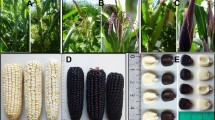Abstract
Open pollinated maize varieties are one of the best options for farmers who cannot afford the cost of hybrids, cultivating maize in low potential environments and cannot pay for inputs such as fertilizers and pesticides. The experiment was conducted to use farmers’ input and feedback on selection of well-adapted, high-yielding, and disease-tolerant maize varieties. Treatments were arranged incompletely randomized block design with three replications. Gibe-1 was better preferred open pollinated maize variety by famers due its cob length, disease tolerance, good husk cover and yield. Gibe-1 provided the highest grain yield in South Achefer (8.8 t ha-1) and the best performing genotype across environments with grain yield of 7.8 t ha-1. Gibe-1 also had a good reaction to common leaf rust and tercicum leaf blight. GGE biplot analysis classified testing environments in to four mega environments and showed high influence of the environment to grain yield with the contribution of variation 59.59% by the environment, 7.25% by the genotype, and 18.38% by interaction. Gibe-1 was identified as the most ideal open pollinated maize variety which produced the highest mean grain yield and was the most stable. Therefore, Gibe-1 is recommended as a potential open pollinated maize variety for Jabitehinan, South Achefer, and similar agro ecologies.
Similar content being viewed by others
References
Akçura, M., Taner, S., & Kaya, Y. 2011. Evaluation of bread wheat genotypes under irrigated multi-environment conditions using GGE biplot analyses. Agriculture, 98(1), 35–40
Badu-Apraku B, Akinwale RO, Menkir A, Obeng-Antwi K, Osuman AS, Coulibaly N, Onyibe JE, Yallou GC, Abdullai MS, Didjera A. 2011. Use of GGE biplot for targeting early maturing maize cultivars to mega-environments in West Africa. Afr. Crop Sci. J. 19, 2: 79–96
Central Statistical Agency (CSA. 2013. Area and production of major crops. Agricultural sample survey, Ethiopia, Adis Abeba, 2013
Emmanuel C, Norton JB, Ashilenje DS. 2014). Performance of a local open pollinated maize variety and a common hybrid variety under intensive small-scale farming practices. Farshadfar, Ezatollah
Rashidi M, Jowkar MM, Zali H. 2013). GGE biplot analysis of genotype×environment interaction in chickpea genotypes. Eur. J. Exp. Biol. 3: 417–423
Jaradat A., Abdullah A., Walter Goldstein, and Kenton Dashiell. 2010. Phenotypic structures and breeding value of openpollinated corn varietal hybrids. Int. J. Plant Breed. 4.1: 37–46
Khalil IA, Rahman H, Rehman NU, Arif M, Khalil IH, Iqbal M, Ullah H, Afridi K, Sajjad M, Ishaq M. 2011. Evaluation of maize hybrids for grain yield stability in north-west of Pakistan. Sarhad J. Agric. 27, 2: 213–218
Kimani, J.M., Tongoona, P., Derera, J. and Nyende, A.B. 2011. Upland Rice Varieties Development Through Participatory Plant Breeding. ARPN Journal of Agricultural and Biological Science 6(9): 39–49.
Kutka F. 2011. Open-pollinated vs hybrid maize cultivars. Sustainability 3.9: 1531–1554
Matus-Cadiz MA et al. (2003) Genotype X environment interaction for grain color in hard white spring wheat Crop Science 43: 219–226.
Thembinkosi Nyathi T. 2010. Seed Multiplication of Improved Open-Pollinated Varieties. Practical Action
Nzuve F, Githiri S, Mukunya DM, Gethi J. 2013. Analysis of genotype x environment interaction for grain yield in Maize hybrids Ozmen Ilker. O. 2009. Assessment of genotype x environment reaction for grain yield in maize hybrids using AMMI and GGE bi plot analysis. 14(2): 123–135
The Maize Program. 1999. Development, maintenance, and seed multiplication of open-pollinated maize varieties–2nd edition. Mexico, D.F. CIMMYT
Voltas J, van Eeuwijk FA, Igartua E, Garcia del Moral LF, Molina-Cano JL, Romagosa I (2002) Genotype by environment interaction and adaptation in barley breeding: basic concepts and methods of analysis. In: Slafer GA, Molina-Cano JL, Savin R, Araus JL, Romagosa I (eds) Barley science: recent advances from molecular biology to agronomy of yield and quality. New York, Food Product Press, ISBN 1-56022-909-8
Author information
Authors and Affiliations
Corresponding author
Rights and permissions
About this article
Cite this article
Elmyhun, M., Mekonen, M. Participatory varietal evaluation of open pollinated maize in Western Amhara, North-west Ethiopia. J. Crop Sci. Biotechnol. 19, 131–136 (2016). https://doi.org/10.1007/s12892-015-0089-6
Received:
Revised:
Accepted:
Published:
Issue Date:
DOI: https://doi.org/10.1007/s12892-015-0089-6




